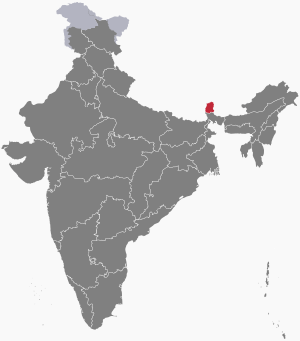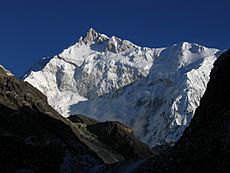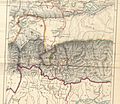Sikkim facts for kids
Quick facts for kids
Sikkim
|
||
|---|---|---|
|
(clockwise from top) Kangchenjunga; Gurudongmar Lake; Rumtek Monastery; Temi Tea Garden
|
||
|
||
| Motto(s):
Kham sum wangdu (Conqueror of the three worlds) |
||
 |
||
| Country | ||
| Admission to Union | 16 May 1975 | |
| Capital | Gangtok | |
| Largest city | Gangtok | |
| Districts | 4 | |
| Area | ||
| • Total | 7,096 km2 (2,740 sq mi) | |
| Area rank | 28th | |
| Population | ||
| • Total | 610,577 | |
| • Rank | 29th | |
| • Density | 86.045/km2 (222.856/sq mi) | |
| Demonym(s) | Sikkimese | |
| Languages | ||
| • Official | ||
| • Additional official |
|
|
| Time zone | UTC+05:30 (IST) | |
| ISO 3166 code | IN-SK | |
| HDI | ||
| HDI rank | 10th (2017) | |
| Literacy | 82.6% (13th) | |
| Website | www.sikkim.gov.in | |
| Assembly of Sikkim abolished monarchy and resolved to be a constituent unit of India. A referendum was held on these issues and majority of the voters voted yes. On 15 May 1975 the President of India ratified a constitutional amendment that made Sikkim the 22nd state of India. | ||
| Symbols | ||
| Emblem | Emblem of Sikkim | |
| Bird | Blood Pheasant | |
| Flower | Noble dendrobium (Dendrobium nobile) | |
| Tree | Rhododendron | |
Sikkim is a beautiful state located in India. It became a part of India in 1975. The people living here mostly have Nepali family backgrounds.
Sikkim is surrounded by other countries and states. To its east is Bhutan, to the west is Nepal, and to the north is the Tibet Autonomous Region of China. To the south, it shares a border with the Indian state of West Bengal.
Sikkim is the state with the smallest number of people in India. It is also the second smallest state in terms of land size, covering about 7,096 square kilometers.
One of the most amazing things about Sikkim is that it is home to the third highest mountain in the world, Mount Kanchenjunga. This giant mountain stands about 8,597 meters (28,169 feet) above sea level.
The capital city of Sikkim is Gangtok. Other important towns include Gayzing, Pelling, Yuksam, and Jorethang. People in Sikkim speak many languages, such as Sikkimese, Lepcha, Tibetan, Nepali, Hindi, and English.
Tourism is a very important way for Sikkim to make money. Many visitors come to see its natural beauty and unique culture.
Sikkim was once quite isolated from the rest of the world. Tibetan people first settled here in the 16th century. Later, in 1890, it became a Protectorate under British rule. The British handed Sikkim over to India in 1949. Finally, in 1975, it officially joined India.
Most of Sikkim's people have Nepalese roots. There are also groups like the Bhutias, who came from Tibet and Bhutan, and the Lepchas, who were originally nomads. Many Nepalese people in Sikkim follow Hinduism. However, the former royal family and officials were Buddhist. Sikkim is famous for its many Buddhist monasteries. People often speak Tibeto-Burmese languages and dialects.
Contents
Mountains and Hot Springs
Sikkim is the second smallest state in India, after Goa. But it has many different natural features. These include thick forests, flowing rivers, and tall mountains. Most of the very high mountains, over 6,100 meters (20,000 feet) tall, are in the western part of the state. Mount Kanchenjunga is one of them.
Other tall mountains in this area include Kabru (the second tallest), Sinilchu, Pandim, and Rothong. On the eastern side, the highest peak is Paunhri, which is about 6,700 meters (22,000 feet) tall. Many mountains in Sikkim have never been climbed. This is because the local people consider them sacred and believe climbing them would make them lose their holiness.
Sikkim also has many hot springs. These springs are known to be good for health. Some of the main hot springs are at Phurchachu (Reshi), Yumthang, and Borang. All these hot springs have a lot of sulfur. They are usually found near river banks. The water in these hot springs is usually around 50°C (122°F).
Climate and Weather
Sikkim experiences five different seasons: winter, summer, spring, autumn, and the monsoon season. The climate in Sikkim changes a lot from south to north. In the south, it's sub-tropical, meaning it's warm. In the far north, it's like a tundra, which is very cold.
Most areas where people live have a temperate climate. This means temperatures rarely go above 28°C (82°F) in summer. The average yearly temperature for most of Sikkim is about 18°C (64°F).
Sikkim is one of the few states in India that gets regular snowfall. The line where snow starts to fall ranges from 6,100 meters (20,000 feet) in the south to 4,900 meters (16,000 feet) in the north. The cold, tundra-like region in the north is covered in snow for four months each year. Temperatures there often drop below 0°C (32°F) almost every night. In the mountains of north-western Sikkim, the peaks are frozen all year round. Temperatures can drop to as low as -40°C (-40°F) in winter because of the high altitude.
During the monsoon season, Sikkim gets very heavy rains. These rains increase the chance of landslides, where large amounts of earth and rocks slide down hills. The longest period of continuous rain recorded in Sikkim was 11 days. Fog is also common in many parts of the state during winter and monsoons. This can make travel difficult and dangerous.
Lakes of Sikkim
Sikkim is home to several beautiful lakes. One well-known lake is Lake Changu (also called Tsomgo). It is located about 35 kilometers from Gangtok, on the way to Nathula. This lake sits at a high altitude of about 3,693 meters (12,116 feet) above Sea level.
Two other lakes close by are Bidangcho and Mememcho. Lake Kechopari is another famous lake. You can find it between the towns of Gyalshing and Yoksum.
Many lakes in Sikkim are found near the western border. These include Laxmipokhari, Lampokhari, Majurpokhari, Dud Phokhari, and Samiti Lake. There are also the twin lakes of Ram-Laxman in this area.
The largest lake in Sikkim is Gurudogmar, which is located in North Sikkim.
Food and Local Dishes
The people of Sikkim, known as Sikkimese people, usually eat simple but tasty meals. Their main foods include rice, green vegetables, potatoes, and dal (a lentil soup). They also enjoy traditional Nepali foods like sinky, Kenama, and Gundruk.
Momo is a very popular treat in Sikkim, originally from Nepal. These are dumplings made by stuffing flour dough with meat and vegetable fillings. Momos are often served with soup and a spicy chili sauce. You can find them in almost every local restaurant and fast food shop.
Thukpa is another popular dish. It is a noodle soup that usually contains vegetables and beef.
Seal Roti is a traditional Nepali food. It is made by grinding rice and water into a paste, which is then deep-fried. People usually eat Seal Roti with potato curry. This dish is often prepared during local festivals like Dasai and Tihar.
Gundruk is a dish made from the leaves of the mustard oil plant. The leaves are dried in the sun and then boiled with other ingredients to create a flavorful dish.
Images for kids
-
Guru Rinpoche, the patron saint of Sikkim
-
Sikkim is in the lower center of this NASA satellite photo of the Tibetan Plateau.
-
The red panda is the state animal of Sikkim.
-
The runway at Pakyong Airport, the first new airport built in Northeast India.
-
The Teesta River is considered the state's most important waterway.
-
M. G. Marg in Gangtok.
-
Temi Tea Garden, Namchi, Sikkim.
-
Vishwa Vinayak Temple at Rhenock.
See also
 In Spanish: Sikkim para niños
In Spanish: Sikkim para niños






























